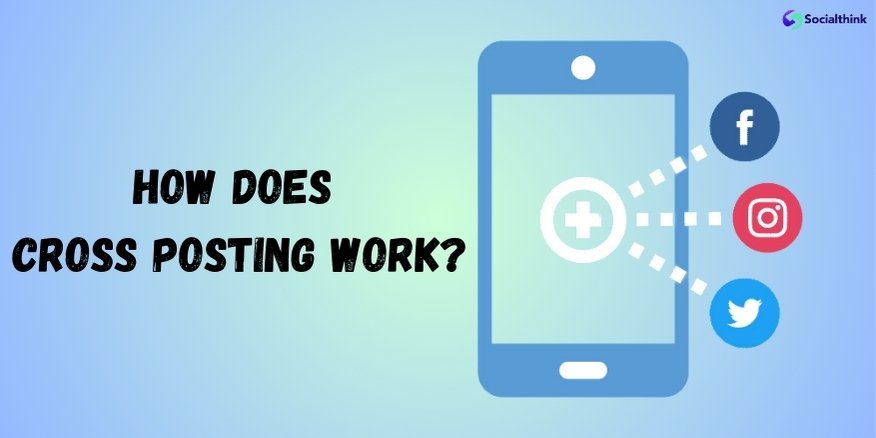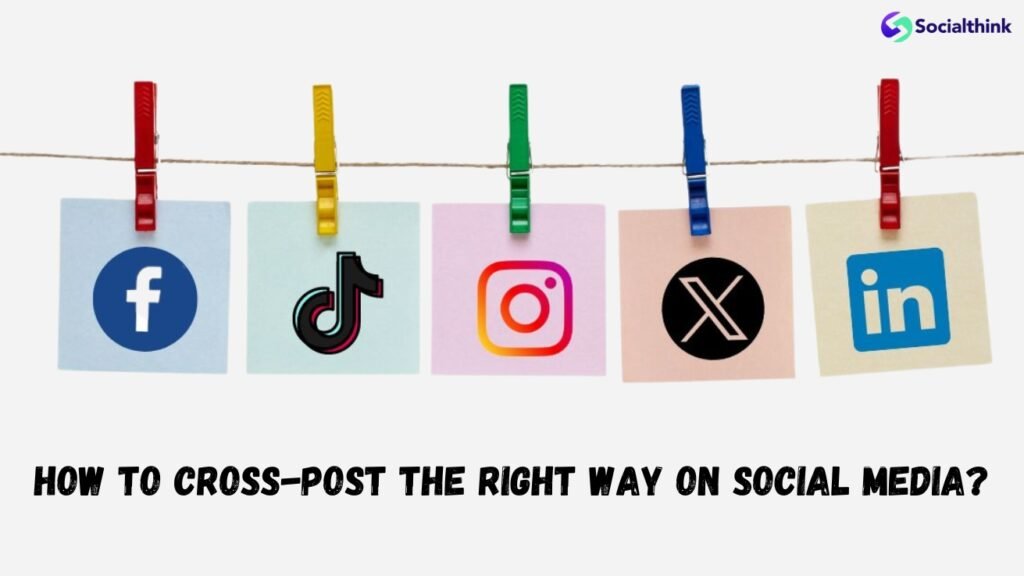Cross Posting on Social Media: What is it & How it Works
Social Think is a leading social media strategy and analytics company that helps businesses leverage social platforms to achieve their goals. Our data-driven insights and proven strategies enable brands to effectively engage audiences and drive measurable results.
In this article, we’ll dive into the world of cross-posting on social media and share best practices to maximize your online presence.
What is Cross-Posting?

Cross-posting is the practice of sharing the same piece of content across multiple social media platforms. This can include posting identical updates, images, or videos on different networks like Facebook, Twitter, Instagram, LinkedIn, and other different social media platforms. The goal is to reach a larger audience and increase brand visibility without creating unique content for each platform.
This strategy is an effective way to save time and effort in content creation and helps maintain consistency across all social media channels by choosing the right type of content for each platform.
What is Cross-Posting on Social Media?

In the context of social media marketing, cross-posting involves repurposing content across various social channels to maximize reach and engagement. Instead of creating separate posts for each platform, marketers can share a single piece of content tailored to the specific requirements and audience preferences of each network.
How Does Cross Posting Work?

Cross-posting works by adapting a core piece of content to fit the unique features and best practices of each social media platform. This may involve adjusting the post’s character count, hashtags, visuals, and tone to align with the expectations of different audiences.
Many social media management tools offer cross-posting functionality, allowing marketers to schedule and publish content across multiple networks simultaneously.
Why Should You Cross-Post?

There are several compelling reasons to include cross-posting into your social media strategy:
- Save time and effort: By repurposing content across platforms, you can maintain an active presence without creating entirely new posts for each channel.
- Increase brand visibility: Sharing your content on multiple networks exposes your brand to a broader audience, potentially attracting new followers and customers.
- Boost engagement: Cross-posting allows you to capitalize on the unique engagement patterns of each platform, such as hashtags on Instagram or trending topics on Twitter.
What to Watch Out For When Cross-Posting?
While cross-posting offers numerous benefits, there are some pitfalls to avoid:
- Ignoring platform-specific best practices: Each social network has its own character limits, image sizes, and audience preferences. Failing to optimize your content accordingly can lead to poor performance.
- Overusing automation: While scheduling tools are valuable for efficiency, relying too heavily on automation can make your posts appear robotic and inauthentic.
- Neglecting audience interaction: Cross-posting should not replace genuine engagement with your followers. Make sure to monitor comments and messages across all platforms and respond promptly.
Is Cross-Posting a Good Idea?
The effectiveness of cross-posting depends on your specific social media goals and target audience.
Let’s explore the pros and cons:
The Pros Of Cross Posting On Social Media
- Saves time by repurposing content across multiple platforms
- Increases brand visibility and reach
- Allows you to engage with different audience segments
- Helps maintain a consistent posting schedule
The Cons Of Cross Posting On Social Media
- May appear inauthentic if not tailored to each platform
- Can lead to audience fatigue if overused
- Requires careful monitoring to avoid appearing spammy
- May not always align with the unique culture of each network
How to Cross-Post The Right Way on Social Media?

To maximize the benefits of cross-posting while minimizing potential drawbacks, follow these best practices:
- Adapt Your Content: Tailor your posts to the unique features, audience preferences, and best practices of each network. This may involve adjusting the copy, hashtags, visuals, and tone to resonate with different user bases.
- Choose the Right Content Type: Not all content is suitable for cross-posting. Focus on evergreen topics and valuable resources that will remain relevant across platforms. Avoid time-sensitive or platform-specific content that may not translate well.
- Optimize Your Images For Different Platforms: Ensure your visuals are optimized for the specific image sizes and aspect ratios of each network. Use high-quality graphics that align with your brand aesthetic and capture attention in busy social media feeds.
- Avoid Excessive Cross-Posting: While cross-posting can save time, overusing this tactic can make your brand appear lazy or inauthentic. Aim for a balanced mix of cross-posted and platform-specific content to keep your presence fresh and engaging.
- Use Analytics to Improve Your Strategy: Regularly review your social media analytics tools to identify top-performing cross-posted content and adjust your approach accordingly. Pay attention to metrics like reach, engagement, and click-through rates to optimize your strategy over time.
How to Include Social Media Cross-Posting in Your Social Media Strategy?

To effectively include cross-posting into your broader social media marketing efforts, follow these steps:
Step 1: Identify the Platforms You Want to Cross-Post On
Evaluate which social networks align with your target audience and business goals. Consider factors like user demographics, content formats, and engagement patterns to prioritize your cross-posting efforts.
Step 2: Create a Content Calendar
Develop a content calendar that outlines your cross-posting schedule and the specific pieces of content you plan to share across platforms. This will help you maintain consistency and avoid over-posting.
Step 3: Use Scheduling Tools
Leverage social media management tools like Hootsuite, Sprout Social, or Buffer to streamline your cross-posting process. These platforms allow you to schedule posts in advance and publish content across multiple networks simultaneously.
Step 4: Monitor and Measure Your Results
Regularly track the performance of your cross-posted content using native analytics tools or third-party platforms. Identify which posts resonate with each audience and adjust your strategy accordingly.
Step 5: Continuously Evaluate and Optimize
As social media platforms evolve and audience preferences shift, it’s essential to continually assess the effectiveness of your cross-posting efforts. Be willing to experiment with new tactics, refine your approach, and adapt to changing best practices.
Is There An App For Cross-Posting On Social Media?
Yes, there are several social media management tools that offer cross-posting functionality. Some popular options include:
- Hootsuite
- Sprout Social
- Buffer
- Agorapulse
- CoSchedule
These platforms allow you to create, schedule, and publish content across multiple social networks from a single dashboard, streamlining your cross-posting efforts.
How to Cross-Post on Social Media Without Looking Spammy?
To avoid appearing spammy when cross-posting, follow these guidelines:
- Don’t Ignore the Audience and the Tone of Each Platform: Tailor your content to the unique culture and expectations of each social network. Adjust your language, hashtags, and visuals to align with platform-specific best practices.
- Don’t Forget to Optimize Your Images and Videos: Ensure your visual content is optimized for the specific image sizes and aspect ratios of each platform. Use high-quality graphics that capture attention and align with your brand aesthetic.
- Mix Up The Timing: Avoid publishing the same post simultaneously across all platforms. Stagger your cross-posting schedule to reach audiences at optimal times for each network.
- Add Unique Comments and Captions: While the core content may remain consistent, add platform-specific captions or comments to make each post feel more authentic and tailored to that particular audience.
- Use Different Post Formats: Experiment with various content formats, such as images, videos, polls, or stories, to keep your cross-posted content fresh and engaging.
- Respond to Comments and Messages: Engage with your audience by promptly responding to comments and messages across all platforms. This helps build relationships and shows that you value your followers’ input.
How to NOT Cross-Post on Social Media?
To avoid common cross-posting pitfalls, steer clear of these practices:
- Cross-Posting Everything: Be selective about the content you choose to cross-post. Not every piece of content will resonate equally across all platforms.
- Using Incorrect Visuals: Failing to optimize your images and videos for each platform’s specific requirements can make your content appear unprofessional or ill-fitting.
- Not Following the Character Limits: Exceeding the character limits on platforms like Twitter can result in truncated posts that fail to convey your full message.
- Not Being Creative: Simply sharing identical content across all networks without any customization can make your brand appear lazy or inauthentic.
- Not Using Automation For Efficiency: While it’s essential to avoid over-automating, failing to leverage scheduling tools can lead to inconsistent posting and missed opportunities for engagement.
Can CrossPosting Lead to Penalties on Social Media Platforms?

In most cases, cross-posting does not directly lead to penalties on social media platforms.
However, if your cross-posting practices are perceived as spammy, inauthentic, or in violation of a platform’s terms of service, you may face consequences such as reduced reach or even account suspension.
To avoid penalties, focus on providing value to your audience and adhering to each platform’s best practices.
What Are The Best Practices For Cross-Posting On Social Media?

To maximize the effectiveness of your cross-posting efforts, keep these best practices in mind:
- Don’t Cross-Post Everything: Be strategic about the content you choose to share across platforms. Focus on evergreen, high-value posts that align with your overall social media goals.
- Pay Attention to Character Count and Links: Ensure your posts fit within the character limits of each platform and that any links are properly formatted and functional.
- Choose the Correct Visuals: Use high-quality images and videos that are optimized for each network’s specific size and aspect ratio requirements.
- Leverage Automation For Consistency: Use social media management tools to schedule your cross-posted content in advance, ensuring a consistent posting cadence across all platforms.
FAQ’s:
How Can I Customize Content For Each Platform Without Overlapping?
Focus on adapting the core message of your content to fit the unique features and best practices of each platform. This may involve adjusting the copy, hashtags, visuals, and tone while maintaining the overall theme or purpose of the post.
Is Cross-Posting Commonly Used in Social Media Marketing?
Yes, cross-posting is a widely used tactic among social media marketers to maximize reach and efficiency. However, it’s essential to approach cross-posting strategically to avoid appearing spammy or inauthentic.
Does Cross Posting Help Reach a Wider Audience?
When done effectively, cross-posting can expose your content to a broader audience across multiple platforms. This can help attract new followers and potential customers who may not have discovered your brand otherwise.
Is it Okay if I Repost the Same Content on Each Platform?
While it’s acceptable to share the same core content across platforms, it’s essential to tailor your posts to the unique characteristics and audience preferences of each network. Avoid publishing identical posts simultaneously, as this can appear lazy or inauthentic.
Is There a Recommended Frequency For Cross Posting on Different Platforms?
The optimal frequency for cross-posting varies depending on your industry, audience, and social media goals. As a general rule, aim to maintain a consistent posting schedule across all platforms without overwhelming your followers. Use analytics to determine the best times and frequencies for your specific audience.
How Can Analytics and Insights Help Optimize Cross Posting Efforts?
Regularly reviewing your social media analytics can help you identify top-performing cross-posted content, optimal posting times, and audience engagement patterns. Use these insights to refine your cross-posting strategy and maximize the impact of your content.
Are There Any Risks in Using Third-Party Cross Posting Tools?
While third-party cross-posting tools can be valuable for streamlining your social media efforts, there are some potential risks to consider.
These may include security concerns, limitations in customization options, or the possibility of the tool becoming outdated or unsupported.
To minimize these risks, choose reputable, well-established tools and regularly review their performance and compatibility with your social media platforms.
Conclusion
Cross-posting on social media can be a powerful strategy for maximizing your brand’s online presence and engaging with a wider audience.
Ensure your content suits each platform by using automation tools and monitoring your performance to seamlessly integrate cross-posting into your social media strategy.
At Social Think, we specialize in helping businesses develop data-driven social media strategies that deliver measurable results.
Our team of experts can guide you through the process of optimizing your cross-posting approach, ensuring that your content resonates with your target audience across all platforms.
To learn more about how Social Think can elevate your social media presence, visit our website or contact us to schedule a consultation. Let us help you unlock the full potential of cross-posting and take your social media marketing to the next level.







